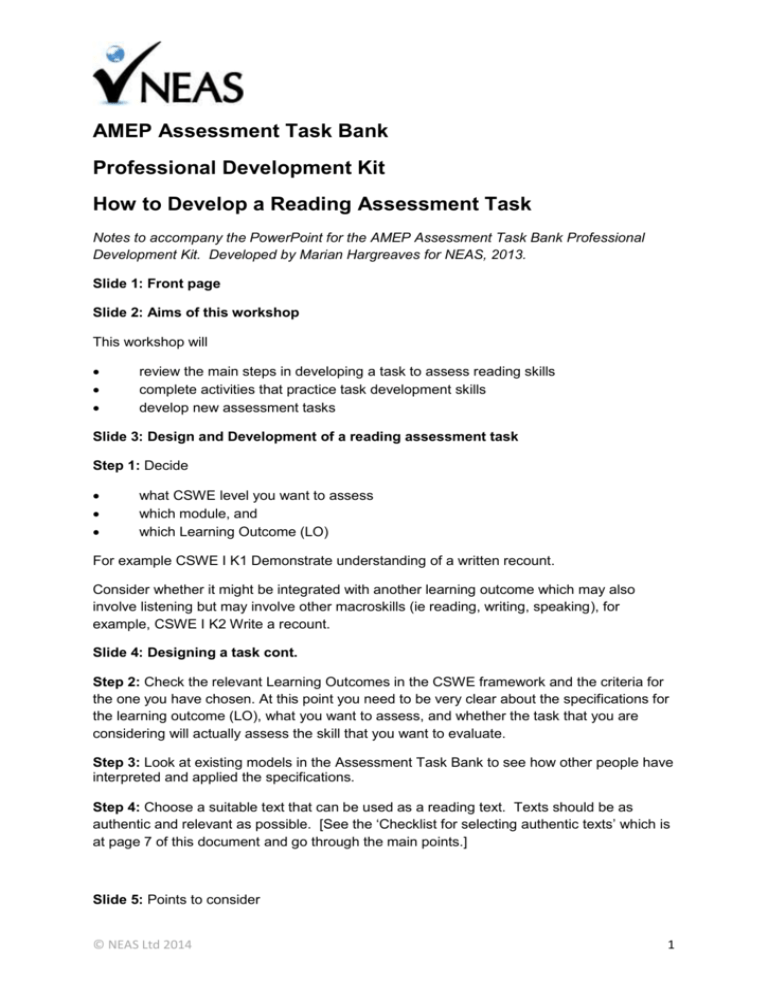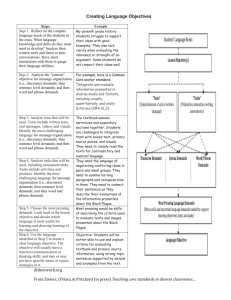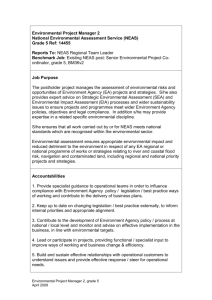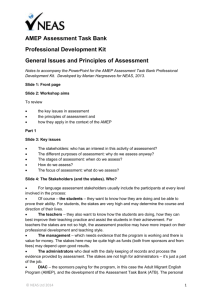How to Develop a Reading Assessment Task notes
advertisement

AMEP Assessment Task Bank Professional Development Kit How to Develop a Reading Assessment Task Notes to accompany the PowerPoint for the AMEP Assessment Task Bank Professional Development Kit. Developed by Marian Hargreaves for NEAS, 2013. Slide 1: Front page Slide 2: Aims of this workshop This workshop will review the main steps in developing a task to assess reading skills complete activities that practice task development skills develop new assessment tasks Slide 3: Design and Development of a reading assessment task Step 1: Decide what CSWE level you want to assess which module, and which Learning Outcome (LO) For example CSWE I K1 Demonstrate understanding of a written recount. Consider whether it might be integrated with another learning outcome which may also involve listening but may involve other macroskills (ie reading, writing, speaking), for example, CSWE I K2 Write a recount. Slide 4: Designing a task cont. Step 2: Check the relevant Learning Outcomes in the CSWE framework and the criteria for the one you have chosen. At this point you need to be very clear about the specifications for the learning outcome (LO), what you want to assess, and whether the task that you are considering will actually assess the skill that you want to evaluate. Step 3: Look at existing models in the Assessment Task Bank to see how other people have interpreted and applied the specifications. Step 4: Choose a suitable text that can be used as a reading text. Texts should be as authentic and relevant as possible. [See the ‘Checklist for selecting authentic texts’ which is at page 7 of this document and go through the main points.] Slide 5: Points to consider © NEAS Ltd 2014 1 Know your specifications (ie the curriculum with the criteria and conditions of assessment). Choose texts of appropriate length (The curriculum may specify a range, but in any case you do not want to overburden your learners – while still giving them a task that will show the extent of their ability). Choose texts not dissimilar to those in existing assessment tasks so that the tasks are comparable. For specific skills eg scanning, find texts which have the specified elements that have to be scanned for. These may have to be built into the text or adapted. Choose texts that have a recognisable structure, eg recount or report. Choose texts that are interesting but not over exciting or disturbing. Consider candidates’ background knowledge – it may be very different between students and should never be assumed. Do not use texts that require cultural knowledge (especially Australian cultural knowledge, unless it has been specifically taught, eg snags at a bbq). Do not use texts which learners have already read in class or for homework. Slide 6: Designing a task cont. Step 5: Evaluate the text in detail according to the specifications for the LO in the CSWE and consider the following criteria: Topic interest level for learners bias (cultural, gender, religious and so on) avoid very familiar topics. Difficulty length (density of information) difficulty of vocabulary (technical, colloquial) difficulty of grammar (such as amount of embedding (eg relative clauses), verb tenses etc) structure of discourse or genre amount of contextualisation (for example, supporting graphics, introductions). Nature of input consider the effects of formatting, fonts, legibility and so on. If the task uses colour, will this photocopy well into greyscale? Suggestion: Activity 1.1 Selecting and adapting a text, could be done at this point. A new text could be sourced or written, or you could start by looking at the text supplied for the activity. Slide 7: Designing a task cont. Step 6: Modify the text as necessary. Unless you specifically write the text yourself, some change will almost always be necessary to take into account any of the issues listed above or to make it fit the specifications for the LO. For a reading text this might mean cutting the text, expanding, reformatting and so on. You might need to build in redundancy if items are too close together, change the structure and include more discourse markers, take out ambiguities, include more information/propositional content and so on. © NEAS Ltd 2014 2 It is effective at this stage to have some idea of the question items that you plan to develop to go with the text. For example, if the criteria asks for the learner to show knowledge of vocabulary, appropriate lexical items need to be included. Suggestion: Use PD Kit Question Items (on ATB website page) at this point or hand out Question types overview. Step 7: Develop the questions Provide a variety of questions, but not so many as to be confusing. Ensure that the students are familiar with the type of question and understand what they are supposed to do. Ensure that students know what is expected of them. Start with some easy questions as a lead-in. Ensure that questions follow the text ie the answer to Q1 comes before the answer to Q2, and summary questions come at the end. Be aware of test method effect. This refers to the difficulty of certain item types and the familiarity that learners have with different types. For example, if learners have not done a matching activity before, they may not know how to do it and either waste time working out what they have to do or get it wrong because they didn’t know what was required. Test preparation courses usually include a lot of practice with the types of items that will be met in the test. Use a range of item formats. In order to minimise test method effect, it is a good idea to use a range of item types in the task. In this way, learners who find one type difficult won’t be overly disadvantaged. However, you need to be careful that the task isn’t too cognitively demanding because there are too many different item types – balance is important. Slide 8: Designing a task cont. Step 8: Write the rubrics. Consider any additional instructions for the teacher that may be necessary. Remember to make the language of instructions to the learner at least as easy as the language of the text of the assessment itself. These instructions need to be simple. You don’t want the learners to get stuck because they don’t understand the instructions! They should be consistent for all tasks in that LO. Step 9: Write and check the answer key/marking guide. Ensure that there are only a few possible correct answers. Check whether the responses correspond to what you were expecting. If a question produces more than three alternative, correct answers, moderate the items and/or the text. Similarly, if a question demands quite a long, written, response, consider using a different type of question, eg a gap fill or cloze. Slide 9: Review. Step 10: Do the task yourself, check you haven’t forgotten anything! © NEAS Ltd 2014 3 Step 11: Get someone else to look at and evaluate the task. Nobody, however skilled and experienced, can write an appropriate and successful assessment task by themselves. Getting a colleague to look at the task will raise ideas and questions not previously thought of. Step 12: Pilot the task on students. This is essential. Learners have very different perspectives from their teachers, and, as they struggle to understand and come to grips with living in Australia and using English, their interpretations of a task may produce some completely unexpected responses. Remember that it is the task that is being assessed, not the students! The students should be made aware of this and that their comments will be valued. Tasks should be piloted on learners who have reached competency and are about to be assessed, or who have recently moved up a level and are therefore only just above the skill level being tested. Step 13: Modify as necessary and appropriate according to feedback from piloting. Step 14: Get the task proofread by someone who has not been involved in its development. This is particularly useful in checking the answer key as often the text and questions get modified, but the answer key is forgotten. Suggestion: Activity 3, on Piloting, could be done at this point. Slide 10: Handout: How to develop a reading assessment task – overview (see below for handout). Slide 11: Activities This is an outline of suggested activities, with material available in separate files. You may choose to do the activities at the suggested points during the powerpoint presentation, or to do one or more following the presentation. This slide is for the latter situation and may be omitted if you have already done the activities. Activity 1.1: selecting and adapting the text CSWE I K1 Demonstrate understanding of a written recount (Moving House) Activity 1.2: developing questions for the learning outcome Activity 1.3: develop a Multiple Choice Question for criterion 1.1: Demonstrate understanding of topic/participant/s Activity 1.4: develop a sequencing question for criterion 1.2: Demonstrate understanding of sequence of events Activity 2: Sister Emily CSWE 3 K1 Demonstrate understanding of a biography ‘Sister Emily’ This text is suitable for assessing and adjusting the difficulty level of a text. ‘Sister Emily’ is a task currently on the Assessment Task Bank, but the text is not the same as the one for this activity. © NEAS Ltd 2014 4 This is an alternative text to assess, modify and develop questions items for a CSWE 3 learning outcome, cf Activity 1.1 Activity 3: Spot the problems! An activity to show the importance of piloting. CSWE I GI Read a Description “Jane” Slide 12: References © NEAS Ltd 2014 5 How to develop a reading assessment task – overview • Decide what aspects of reading you want to assess. • Check the curriculum. • Consider corresponding/integrated Learning Outcomes (LO). • Select an authentic text for the LO. Refer to ‘Checklist for selecting authentic texts’. • Modify the text and think about the question items that you want to use. Refer to the Questions types overview handout. • Write the rubrics. • Write and check the answer key/marking guide. • Do the task yourself, check you haven’t forgotten anything! • Get someone else to look at and evaluate the task. • Pilot the task on students. See the Piloting Checklist and analysis grid. Use the Teacher evaluation form if preferred. (These are located on the ATB Website page). • Modify as necessary. © NEAS Ltd 2014 6 Checklist for selecting authentic texts for reading and listening assessment 1. Choose the learning outcome/s that you want to assess. 2. Check the criteria from the curriculum. 3. Choose a topic. Consider topics that are: relevant to the learners interesting for the learners appropriate for the current learning focus, for example work issues practical to assess. Avoid very familiar topics, traumatic topics, and texts with undue cultural, gender or religious bias. 4. Look at any models you could use as a guide, but avoid texts that the students have already read. 5. Collect as many potential texts as possible. Look for texts that have a lot of discrete information that can be used to formulate questions. 6. Consider the difficulty of the text including: • length • density of information • difficulty of vocabulary • difficulty of grammar • discourse structure • contextualisation. 7. Start modifying the texts according to the criteria and the level of the students. Consider how much can be modified to suit the level of difficulty and the Learning Outcome without losing all authenticity. You may need to: • • • • write in redundancy (to space out the items or add extra detail) change the structure (to allow for a sequencing question) remove ambiguities include more discourse markers. Remember the importance of font and formatting for text comprehension. 8. At the same time as modifying the text, think about the sort of questions you would like to write. Does the text provide the necessary opportunity to ask appropriate question items? Use the Question types overview handout to remind yourself of the options available. Don’t be tempted to include dichotomous items (yes/no; true/false). 9. Is there a question of copyright regarding the text? Has it come from some other publication, do you need to get permission from any authors or participants? Reading task evaluation checklist © NEAS Ltd 2014 7 CSWE Level ______ Learning Outcome Title of task ______________________________________________________________ Task conditions Complies with curriculum and criteria Use of dictionary is stated Compulsory/optional questions (if any) are identified Task characteristics Complies with curriculum and criteria Assesses a range of the skills/learning outcomes required for this level Equivalent difficulty to other tasks at this level Includes visual clues, introduction and so on to contextualise the task Rubrics are clear Format and layout are clear Reading text Complies with curriculum Discourse difficulty is appropriate Items Complies with curriculum and criteria Language of items is simple Item types are familiar Rubrics are clear Items produce unambiguous responses Text/item relationship Items in text order Limited number of possible responses for each item Answer key and Marking Guide Answer key indicates all acceptable responses Directions to teachers are included (for example the marking for each question) © NEAS Ltd 2014 8











